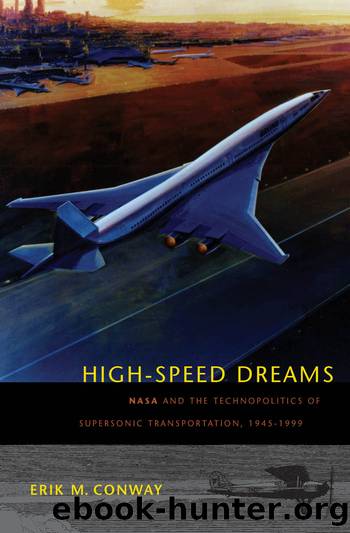High-speed Dreams : Nasa and the Technopolitics of Supersonic Transportation, 1945-1999 (9781421410432) by Conway Erik M

Author:Conway, Erik M. [Conway, Erik M.]
Language: eng
Format: epub
ISBN: 080188067X
Publisher: JohnsHopkinsUP
Published: 2005-09-15T05:00:00+00:00
The 1970s had not been kind to supersonic enthusiasts. The anti-SST campaigns and the ozone problem had left the public deeply suspicious of the SSTâs environmental consequences and equally suspicious of the motives of SST supporters. Concordeâs long-predicted failure destroyed the promotersâ chief argument, that the Europeans would gain technological superiority over the United States through their dogged persistence in getting the highly advanced airplane to market. Ongoing energy shortages made even second-generation SST economics appear questionable, and airlines were not interestedâespecially since NASA was funding a program to substantially reduce subsonic aircraft fuel consumption, thus improving subsonic jetsâ economics vis-Ã -vis prospective SSTs. Whatever the merits of an advanced supersonic transport, finally, neither Congress nor the Reagan administration would pay for it, given the tremendous budget pressures produced by the inflationary economy. For several reasons, then, the AST could not make political progress.
Despite its lack of political success, however, the advanced SST research effort was not wasted. By far the most important outcome of the 1970s research was the accidental discovery of the ozone problem. By 1980, research funded by DOT and NASA had demonstrated that SSTs were less threatening to the ozone layer than Johnston and Crutzen had initially thought, leading to a relatively well-accepted belief that future combustor technology could render an AST ozone-neutral. Instead, SST-inspired research had shown the major threat to Earthâs ultraviolet shield was chlorofluorocarbons, which led to a ban on CFC-powered aerosol sprays in the United States in 1978, a worldwide ban on CFC manufacture in 1987, the institutionalization of stratospheric research at NASA, and a permanent NASA program to monitor the stratosphereâs composition.
The SCAR/VCE program held its own successes. The Navy-NASA Engine Program was still the dominant engine cycle analysis software in the year 2000, and the successor that was evolving relied heavily on its code. ATLAS, NASTRAN, and FLEXSTAB became the cores of more sophisticated software and thus continued to evolve as well. These tools, in turn, reduced the cost of designing new aircraftâeven subsonic onesâsubstantially. Hence while SCAR/VCE did not succeed at generating a second-generation supersonic transport development program, the effort still increased the manufacturersâ future capabilities. The program was also highly productive. Over its lifetime, its researchers produced more than a thousand technical publications on subjects ranging from supersonic aerodynamics to advanced materials, structural design, software complexes, and emissions and noise reduction.99 Viewed solely on its merits as a technology program, SCAR/VCE was very successful.
The desire to make a supersonic future possible, finally, also helped transform the kinds of aeronautical research NASA performed. In previous decades, the agency had focused on aerodynamic and structural research. Due to the space race, it had ceased air-breathing propulsion research and had had to restart it to support both the SCAR program and the noise abatement research that airlines, aircraft manufacturers, the Congress, and urban residents all demanded. As NASA official Charles W. Harper had noted in 1969, the agencyâs traditional aerodynamics focus was no longer sufficient to address the SSTâs fundamental problems.100 To
Download
This site does not store any files on its server. We only index and link to content provided by other sites. Please contact the content providers to delete copyright contents if any and email us, we'll remove relevant links or contents immediately.
Cecilia; Or, Memoirs of an Heiress — Volume 1 by Fanny Burney(32434)
Cecilia; Or, Memoirs of an Heiress — Volume 2 by Fanny Burney(31871)
Cecilia; Or, Memoirs of an Heiress — Volume 3 by Fanny Burney(31854)
The Secret History by Donna Tartt(18846)
Sapiens: A Brief History of Humankind by Yuval Noah Harari(14252)
Leonardo da Vinci by Walter Isaacson(13182)
The Radium Girls by Kate Moore(11921)
Sapiens by Yuval Noah Harari(5294)
How Democracies Die by Steven Levitsky & Daniel Ziblatt(5128)
The Wind in My Hair by Masih Alinejad(5034)
Homo Deus: A Brief History of Tomorrow by Yuval Noah Harari(4823)
Endurance: Shackleton's Incredible Voyage by Alfred Lansing(4676)
The Silk Roads by Peter Frankopan(4457)
Man's Search for Meaning by Viktor Frankl(4424)
Millionaire: The Philanderer, Gambler, and Duelist Who Invented Modern Finance by Janet Gleeson(4376)
The Rape of Nanking by Iris Chang(4138)
Joan of Arc by Mary Gordon(4013)
The Motorcycle Diaries by Ernesto Che Guevara(4012)
Hitler in Los Angeles by Steven J. Ross(3900)
